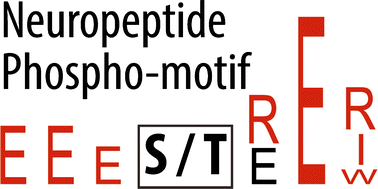Journal of the American Society for Mass Spectrometry ( IF 3.1 ) Pub Date : 2018-03-19 , DOI: 10.1007/s13361-018-1915-0 Christopher B. Lietz 1 , Thomas Toneff 1 , Charles Mosier 1 , Sonia Podvin 1 , Anthony J. O’Donoghue 1 , Vivian Hook 1, 2
Neuropeptides are vital for cell-cell communication and function in the regulation of the nervous and endocrine systems. They are generated by post-translational modification (PTM) steps resulting in small active peptides generated from prohormone precursors. Phosphorylation is a significant PTM for the bioactivity of neuropeptides. From the known diversity of distinct neuropeptide functions, it is hypothesized that the extent of phosphorylation varies among different neuropeptides. To assess this hypothesis, neuropeptide-containing dense core secretory vesicles from bovine adrenal medullary chromaffin cells were subjected to global phosphopeptidomics analyses by liquid chromatography (LC)-mass spectrometry (MS/MS). Phosphopeptides were identified directly by LC-MS/MS and indirectly by phosphatase treatment followed by LC-MS/MS. The data identified numerous phosphorylated peptides derived from neuropeptide precursors such as chromogranins, secretogranins, proenkephalin and pro-NPY. Phosphosite occupancies were observed at high and low levels among identified peptides and many of the high occupancy phosphopeptides represent prohormone-derived peptides with currently unknown bioactivities. Peptide sequence analyses demonstrated SxE as the most prevalent phosphorylation site motif, corresponding to phosphorylation sites of the Fam20C protein kinase known to be present in the secretory pathway. The range of high to low phosphosite occupancies for neuropeptides demonstrates cellular regulation of neuropeptide phosphorylation.

ᅟ
中文翻译:

磷酸肽组学揭示致密核心分泌囊泡中神经肽的差异化磷酸化状态和新型SxE磷酸化基序。
神经肽对于细胞间的通讯以及神经和内分泌系统的调节至关重要。它们是通过翻译后修饰(PTM)步骤生成的,从而导致从激素原前体生成小的活性肽。磷酸化是神经肽生物活性的重要PTM。根据不同神经肽功能的已知多样性,可以假设不同神经肽之间的磷酸化程度不同。为了评估这一假设,通过液相色谱(LC)-质谱(MS / MS)对来自牛肾上腺髓质嗜铬细胞的含有神经肽的致密核心囊泡进行整体磷酸肽组分析。磷酸肽直接通过LC-MS / MS鉴定,间接通过磷酸酶处理然后再进行LC-MS / MS鉴定。数据确定了许多衍生自神经肽前体(例如嗜铬粒蛋白,促分泌素,前脑啡肽和前NPY)的磷酸化肽。在鉴定出的肽中观察到了高水平和低水平的磷酸占用,并且许多高占用磷酸肽代表具有目前未知的生物活性的激素原衍生肽。肽序列分析表明,SxE是最普遍的磷酸化位点基序,与已知存在于分泌途径中的Fam20C蛋白激酶的磷酸化位点相对应。神经肽的高至低磷酸位占据范围证明了神经肽磷酸化的细胞调节。在鉴定出的肽中观察到了高水平和低水平的磷酸占用,并且许多高占用磷酸肽代表具有目前未知的生物活性的激素原衍生肽。肽序列分析表明,SxE是最普遍的磷酸化位点基序,与已知存在于分泌途径中的Fam20C蛋白激酶的磷酸化位点相对应。神经肽的高至低磷酸位占据范围证明了神经肽磷酸化的细胞调节。在鉴定出的肽中观察到了高水平和低水平的磷酸占用,并且许多高占用磷酸肽代表具有目前未知的生物活性的激素原衍生肽。肽序列分析表明,SxE是最普遍的磷酸化位点基序,与已知存在于分泌途径中的Fam20C蛋白激酶的磷酸化位点相对应。神经肽的高至低磷酸位占据范围证明了神经肽磷酸化的细胞调节。对应于已知存在于分泌途径中的Fam20C蛋白激酶的磷酸化位点。神经肽的高至低磷酸位占据范围证明了神经肽磷酸化的细胞调节。对应于已知存在于分泌途径中的Fam20C蛋白激酶的磷酸化位点。神经肽的高至低磷酸位占据范围证明了神经肽磷酸化的细胞调节。

ᅟ











































 京公网安备 11010802027423号
京公网安备 11010802027423号